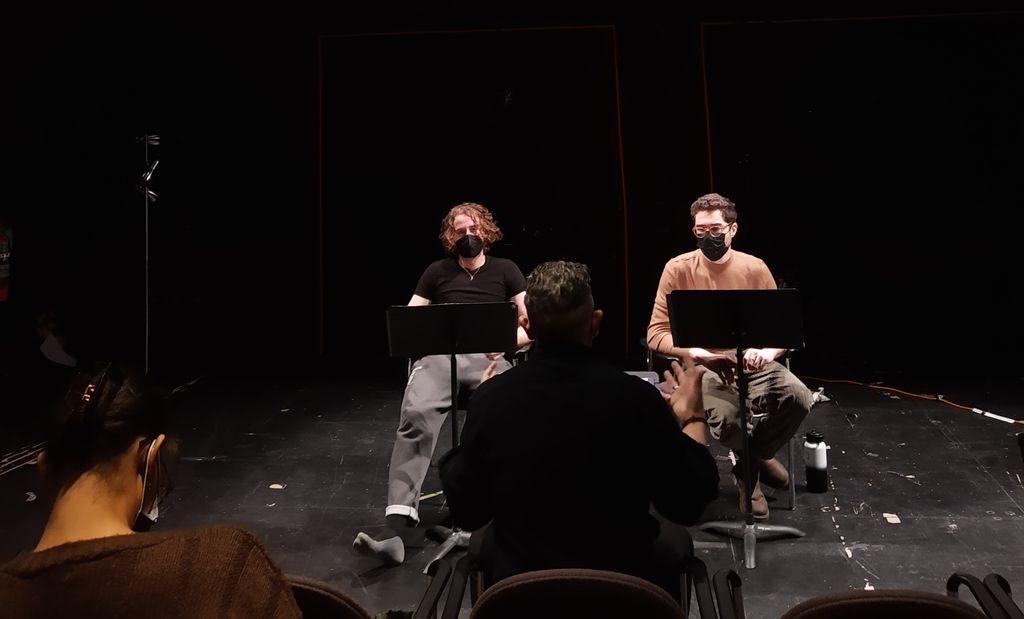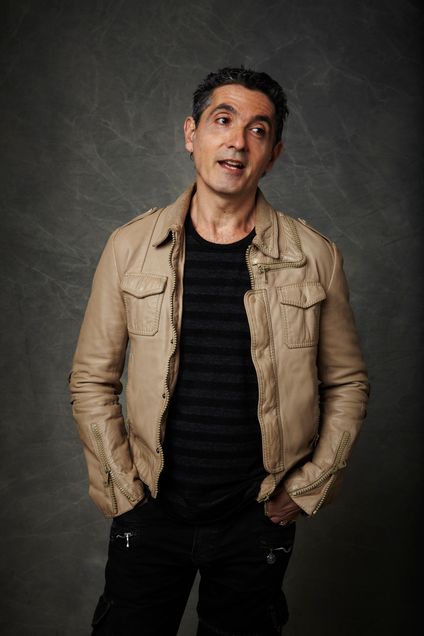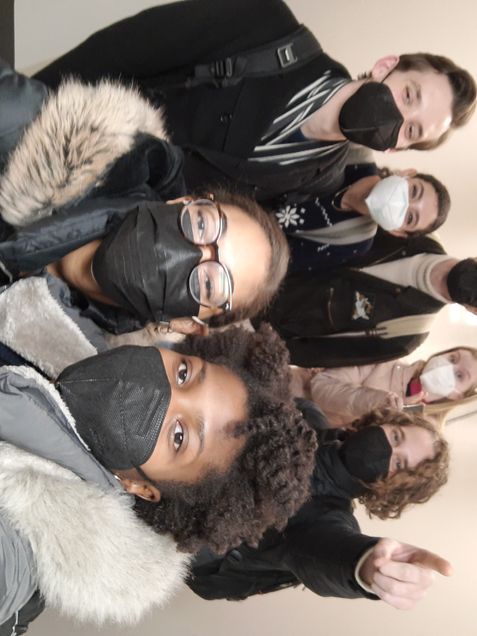BU Theatre Students Work with Award-Winning Director Ain Gordon and Resident Lighting Designer Kelly Martin (CFA’16)

The week and a half-long workshop brought theatre, design, dramaturgy, arts administration, LGBTQ+ studies, and medical BU students together, reflecting on an often-buried moment in history: the start of AIDS.
The early 80s brought a growing wave of chaos with the AIDS crisis. In those early years, affected people and their families and friends were trying to navigate the unknown. How was the disease transmitted? What information was available? What information was being blocked by the government? What news source should be trusted? Is there a treatment, a cure?
Fear consumed the population. Many funeral directors willingly avoided entering an “AIDS ward” to gather a body and provide funeral services. A New York Times (NYT) article released in 1981 distorted the early AIDS history by calling it a “gay cancer.”
In response to the 40th anniversary of the first reported case of AIDS in Philadelphia, three-time Obie-award-winning Writer and Director Ain Gordon wanted to create an alternative memorial to the era’s resilience and tragedy in partnership with Philadelphia’s William Way LGBT Community Center. After conducting research for eighteen months, speaking with families and friends of Philadelphians who succumbed to AIDS, Gordon wrote a play inspired by his research. That play was workshopped at BU College of Fine Arts from January 25 through February 4, with two public staged readings held on February 5 at CFA School of Theatre’s Studio ONE.

“The play is trying to think about how some individuals navigated what was available to know, what information was being blocked (both by the government and by societal attitudes towards ‘homosexuality’) prior to treatment, prior to education, prior to acceptance,” says Gordon. “Philadelphia’s wave of infections began one year after the first two hotspots (San Francisco and New York), but there was no official information sharing system, especially for those not already in the medical community.”
The workshop brought together theatre, design, dramaturgy, arts administration, LGBTQ+ studies, and medical students.
Theatre arts major Edward Sturm (CFA’24) was the dramaturg in the production, dedicated to compiling relevant research. For Sturm, discovering what was unknown during the AIDS epidemic became just as important as discovering what was known.
斯特姆说:“由于罗纳德·里根政府和其他结构性权力如此彻底地忽视了这种流行病,并阻碍了公众教育,医学澳门威尼斯人注册网站研究人员的知识没有到达最需要信息的社区。”
斯特姆是如何将他收集到的澳门威尼斯人注册网站研究应用到制作中的?“在这个项目中,我专注于为演员们创造平易近人的资源,让他们了解艾滋病危机是如何展开的,并理解文本中使用的特定文化和地理参考。”
该剧想象了三个人物:护士、单身男子和唱诗班的唱诗班成员。研讨会由两名波士顿大学学生组成,分别扮演这三个角色。
詹妮尔·格雷斯(24届CFA)是表演专业大二学生,辅修艺术领导力,她是扮演护士角色的演员之一。《护士》由汉普顿·理查兹(Hamptom Richards)饰演,讲述了许多在艾滋病流行前线工作的护士的不同故事。他们故事中的相似之处令人着迷,”格蕾丝说。“以这种亲密的方式了解这段经常被埋葬的历史,让人非常清醒。看到过去和现在的相似之处和不同之处,让我有了很多新的认识。和Ain一起工作非常棒。他是一位美丽的作家,也是一位和蔼可亲、充满激情的导演。”

这些对戈登的看法在整个学生团队中都有。“我喜欢Ain ‘感觉’事情的方式,而不是给出非常具体的方向,”Brenda Dziaddzio (CFA ' 22)说,他是一名戏剧专业的学生,今年5月毕业于SOT的现场绘画工匠证书。“这是我第一次为剧院设计,因为我已经做了很多年的广告艺术总监。我最喜欢的是创造一个实体作品的触觉体验。这比在电视屏幕上看我的作品更有满足感。”
工作通过一个紧凑的时间表,大约10天的排练和塑造设计,助理灯光设计师,麦肯纳·艾伯特(CFA ' 22)回忆什么灯光设计过程的节目是喜欢。“1月25日,星期二,工作坊刚开始的时候,我们做了笔记和焦点讨论,让情节(剧院灯光设计师专门使用的建筑蓝图)成型,然后开始设计。到周五,我们开始进行彩排,以确保下周的技术状态良好。”
Ebert还得到了与CFA校友Kelly Martin (CFA ' 16)合作的机会,Kelly Martin自2017年以来一直与Gordon在几个项目上密切合作。“和凯利一起工作真是太棒了!Ebert补充道。“作为一名即将毕业的大四学生,与一位已经在这个行业站稳脚跟的戏剧学院校友合作真的很有趣。我从他那里学到了很多澳门威尼斯人注册如何处理工作室和像这样的新作品。”
马丁发现他在波士顿大学的时光是最值得的。“这是我第一次与戈登合作创作作品。作为一名作家和导演,艾因在他的脑海中有一个澳门威尼斯人注册如何上演戏剧的强烈画面,由一个小演员直接独白的实用性和他们应得的亲密感推动,”马丁说。“作为一名灯光设计师,我的任务是如何剥离不必要的视觉元素,使其成为舞台上最简洁优雅的画面。举办这个研讨会非常有用,因为它让我有能力把一大堆设计想法扔到剧本中,看看什么能坚持下去。有学生在身边是使这一切成为可能的原因——来自所有有才华的学生的制作支持和麦肯纳的帮助,随着每次排练的想法演变,跟踪我们的轻情节。引入一种根植于专业领域的戏剧制作风格,看看它与教育环境中的戏剧有何不同,这也是令人兴奋的。”
Like Ebert has learned from Martin, Martin recalls his time at BU learning from Associate Professor Mark Stanley, who’s also the Resident Lighting Designer for New York City Ballet. “Mark Stanley’s program excels at teaching both the theoretical and practical aspects of putting together a light plot. The theoretical involves breaking down our understanding of light into its qualities and how our tools and technologies let us manage that light. The practical elements are all about the spatial geometry and physics of light. These are tools that help us determine the best place to hang a light.”
The workshop concluded with two public readings on February 5. The Daily Free Press‘ review on the workshop says it brought light to a historically underrepresented community in an artful fashion.
Looking ahead, Gordon has partnered with Philadelphia’s William Way LGBT Community Center on the play and a Philadelphia premiere is scheduled for May 2022 with BU student participants invited to attend.
“You know, I never really think about what feeling I may manage to evoke in an audience, or that’s not my approach,” says Gordon. “I hope they are engaged by what the characters wrestle with, with who the characters ARE. I hope we can offer another window into that time that is too often collectively labeled ‘the AIDS crisis’ rather than a remembrance of the individuals within.”
Gordon adds, “I have known Professor Mark Stanley for many years professionally, and prior to COVID, he had brought me in to speak with students during their week in New York for their senior thesis. He really spearheaded this whole idea, for which I am enormously grateful.”